Kostenloser Versand ab 30€ Bestellwert!
-
Shop
- Insights
-
Über ROMBO
- Händler
- Plektren-Finder
- Geschenkgutschein
+Kategorien
- accessories
- bass
- bass pick
- bass picks
- bass plectrum
- bass plectrums
- beginner
- bright tone
- chose guitar pick
- chose guitar picks
- chose plectrum
- chose plectrums
- CrystalBright
- Diamond
- Diamond pick
- discipline and guitar
- DIY generation
- durability pick
- durable pick
- eco
- ecoblack
- find guitar pick
- find plectrum
- fingers vs picks
- grip
- grip guitar pick
- guitar accessories
- guitar advantages
- guitar benefits
- guitar career
- guitar health
- guitar injury
- guitar learn
- guitar lesions
- guitar lesson
- guitar method
- guitar noise
- Guitar noise plectrum
- guitar pain
- guitar pick
- guitar pick beginner
- guitar pick bevel
- guitar pick buy
- Guitar pick diamond
- guitar pick durability
- guitar pick durable
- guitar pick eco
- guitar pick features
- guitar pick grip
- guitar pick material
- Guitar Pick Noise
- Guitar Pick online
- guitar pick recycled
- guitar pick recycled material
- guitar pick special features
- guitar pick textures
- guitar pick thickness
- guitar pick variable thickness
- guitar picks
- guitar tone
- guitar warm-up
- guitarpick
- guitarpicks
- hold a guitar pick
- hold guitar pick
- hold guitar picks
- hold pick
- hold plectrum
- hold plectrums
- how to
- how to chose your guitar picks
- jazziii
- learn guitar
- lose guitar pick
- material
- materials
- mental health and guitar
- motivation and guitar
- music
- not to lose guitar pick
- Online guitar
- online guitar pick
- online guitar pick buy
- pick
- pick durability
- pick material
- pick noise
- Picks
- picks vs. fingers
- play bass fingers
- play bass picks
- play bass with fingers
- play bass with pick
- play bass with picks
- play bass with plectrum
- play guitar faster
- plectrum
- plectrum attributes
- plectrum beginner
- plectrum bevel
- plectrum characteristics
- plectrum features
- plectrum grip
- plectrum material
- plectrum noise
- plectrum recycled
- plectrum shape
- plectrum variable thickness
- plectrums
- Plek
- pua
- recycled
- recycled guita pick material
- recycled guitar picks
- recycled picks
- recycled plectrum
- Rombo Diamond
- rombopicks
- tendonitis guitar
- the guitar pick
- tone
- variable thickness
- warm tone
- warm-up guitar

Common Guitar-related Injuries and how to Avoid Pain when Playing the Guitar

Playing the guitar is fun and requires numerous hours of practice. Sometimes guitarists find themselves developing pain in different parts of the body such as their wrists, back, neck, forearm, and/or fingers.
Guitarists underestimate the dangers of injuries. According to the Bureau of Labor and Statistics, in recent surveys, nearly three-fourths of professional musicians reported past injuries and pain that affected their playing.
Every guitarist I know underestimates the risks and frequency of injuries caused by playing an instrument. As with many repetitive activities (like sports), you can prevent some injuries by understanding the root cause. Being aware of this is the only way you can commit to your guitar practice and have a worry-free (and pain-free) guitar-playing routine.
In this article, we will cover the following topics:
- Reasons for injuries caused by guitar playing
- Common guitar injuries and symptoms
- How to avoid injuries and pain when playing the guitar
Disclaimer: This article is not medical advice and is not a replacement for diagnosis or treatment by a qualified medical professional. Our goal is to advise you of some preventive methods to help you avoid injuries in the first place.
1- Reasons for injuries caused by playing the guitar
Playing the guitar, there are many sources of injuries that can be overlooked.
In most cases, the pain caused by playing the guitar starts from a combination of some of these reasons:
- Practice time
- Bad posture
- Too much pressure on the fretboard
- Bad finger technique
- Lack of a warm-up routine#
- Avoiding breaks and fatigue
- Weight of your guitar
- Prior non-guitar-related injury aggravated by playing the guitar
- Genetics (like genetic chronic back pain that can be promoted by playing the guitar)
In chapter 3, we will discuss how to prevent injuries and pain caused by guitar playing and will explain some “best practices” related to these reasons.
2- Common Guitar Injuries and Symptoms
Guitar injuries are serious because they can take guitar players out of the game permanently. There are many examples of these tragedies along with the history of music and their reason is always the same—underestimating the signals that your body sends to you.

If you are experiencing pain in some of the following areas, your body is trying to tell you that something is wrong. In that case, going to the doctor is the best option. If you want to learn how to prevent these injuries, go to chapter 3.
Most injuries can be categorized as RSI or Repetitive Strain Injury. RSIs are often long-term injuries that won't go away easily. These are directly associated with specific activities that involve repetitive movements. Guitar learning is all about repetition.
If you are experiencing pain in any of the following areas, our recommendation is to take a break for a few days and visit the doctor to ensure things aren’t more serious than they seem on the surface.
2.1- Pain in the forearm when playing the guitar:
Unlike what many guitarists think, forearm injuries are not only common for the fretting hand but also for the strumming one. If your hand position is tight, your forearm muscles are likely to tighten up too.

Putting too much pressure on the fretboard or holding the guitar pick with too much tension can develop into tendonitis.
Tendonitis is the inflammation of the tendons—the tissue that connects muscles and bones together and is involved in the function of moving your body properly.
Symptoms are pain, swelling, and motoric problems like limited hand movements. Many guitarists describe it as “the forearm feels like an old rubber band".
2.2- Pain in the hand area when playing the guitar. Wrists and fingers:
We are not talking about fingertips pulp pain known by every beginner guitar player without calluses. Those develop over time, making guitar playing comfortable at some point.
The main issue in these areas is Carpal Tunnel Syndrome that not only affects guitar players, but also any kind of activity that involves fast, precise, and repetitive finger and hand movements like pianists, hairstylists, video gamers, etc.
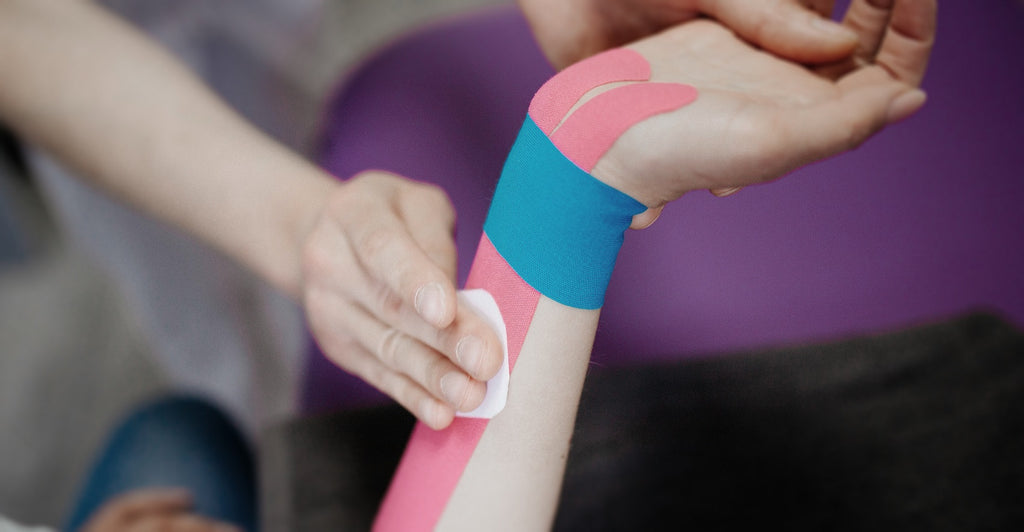
Again, the tendons are involved as in many movement injuries. The flexor tendons that go from the fingertips to the forearm can be easily stressed.
Symptoms are pain, weakness, or motoric problems like limited hand movements.
2.3- Pain in the elbow when playing guitar:
The famous "tennis elbow" is also a guitarist's nightmare. Technically, this is also an issue that concerns the tendons, and its correct name is "lateral epicondylitis."
The main symptoms are pain when gripping the fretboard or pain on the outside edge of the elbow.
As in most problems related to the tendons, the first symptoms are very subtle, and this can be ignored by ambitious guitar players who want to add some extra practice to their daily routines. If you are starting to feel this, the best way to prevent it is to have a rest for a couple of days and visit the doctor if the pain persists.
2.4- Pain in the back and shoulders when playing the guitar:
A lot has been said about posture, and this has a simple reason. Good posture habits can save you from experiencing lots of pain.
The problem with playing the guitar is that you need to position yourself in a bad posture to actually see what your fretting hand is doing properly. When you focus on the movements of your hands, it is very easy to forget what the rest of your body is doing, and you might slouch or sit with your back curved with no tension on it.
Back pain is dangerous because everything here is connected. So symptoms can appear on the shoulders, lower back, upper back, neck, and in other areas. This depends on many individual factors.
Fact is, this can be prevented by practicing good posture and holding the guitar closer to you as we will discuss in chapter 3.
This problem is very common among ambitious beginners that want to scale their skills fast.
A combination of three things causes the pain:
- Looking to your left for hours (or right if you are left-handed). As a beginner, you cannot practice without looking at your fretting hand.
- Fatigue of the neck muscles is caused by a lack of endurance. You are a beginner, so you did not have enough time to adapt to this new environment and movement ranges.
- Last but not least, lack of experience to estimate the reactions your skeleton and muscles might have.

3- How to avoid Injuries and Pain when playing the Guitar:
On an Instagram survey we performed with 455 participants, 64% reported having had some injuries in the past. This means almost two-thirds of the guitarists that participated have experienced some pain or lesions. You are lucky if you are amongst the 36% injury-free guitar players.

Simple actions can make a huge difference in your playing and help you avoid injuries and pain when playing the guitar:
3.1- Warm up before playing the guitar:
Playing at even semi-intense levels is stressful on the arms, hands, and the back and shoulders, just like a gym workout would be. So you need to treat it as a sport.
Warm-up can be something as easy as stretching your fingers or starting off your session by playing some techniques that aren’t as demanding as your current guitar level.

The cool thing about warming up is that once you start playing, your muscles are already prepared to deliver their best performance.
We have summarized our seven favorite warm-ups HERE.
3.2- Proper guitar technique, posture, and guitar position:
I am a big fan of self-learning. I have used self-learning techniques for foreign languages, technical skills, software, and cooking. However, in guitar, and especially in terms of avoiding injuries, I cannot repeat it enough: get a teacher.
A professional experienced teacher can help you not only develop your skills and define your learning path but also avoid and correct bad posture, too much finger tension, wrong guitar position, and other bad habits such as slouching when playing the guitar.

My recommendation if you do not have a teacher:
- Go for 2-3 private lessons that only focus on posture, technique, and guitar position
- Practice as per the advice of the teacher in front of a mirror
Sure, it will cost you some extra money, but it will prevent future problems that have a higher impact on your life than a couple of bucks.
3.3- Play guitar with less tension:
Typical tension areas are the forearms, fingers, and back.
What I did to avoid this is playing simple chords and phrases that I knew well and, while playing, concentrating on other areas of my body: is my back straight? Am I placing too much tension on the fretboard? Am I holding my guitar pick correctly? Can I avoid turning my neck and looking left?
Some hand tension can be avoided by holding the guitar pick properly. If are experiencing this, you can check our article How to hold a guitar pick.
3.4- Breaks and time management when playing the guitar:
There is a rule of thumb amongst experienced guitar players; 50 minutes practice, 10 minutes rest.
In the 10 minutes, you can check harmony and music theory, study some tabs or just stand up and move around to reduce your overall body tension.
This has two advantages:
- It prevents injuries by giving your body a break, and
- You will feel fresh after the break which results in higher quality practice results.
3.5- Do not play the guitar through pain:
If you experience some sort of pain while playing the guitar, this isn’t normal. Stop playing immediately and take a break, then evaluate whether you should go to the doctor or the physiotherapist.
3.6- Play sport:
Having good musculature in other areas of the body helps a lot when playing guitar:
- Muscles with more endurance resist more stress.
- Muscles that are used to exercise recover faster and fatigue slower.
- Regular sport lowers stress levels and diminishes accumulated tensions.
The combination of these aspects make playing sports a great alliance when it comes to guitar playing.
3.7- Use a lighter guitar for practice if you play standing up:
This is only logical: the less weight you put on your shoulders, the less stress you will have to handle. Some professional guitarists use light guitars for practice or even guitar stands and only use their performance guitars for their performances.
This is especially useful for guitar teachers that usually spend their whole days with a guitar in their hands.
3.8- Massages and ice for guitar pain relief:
If you treat guitar playing like a sport—and with sport, I mean high-stress levels caused by muscular movements in some areas of the human body—then you need a cool down.

Massaging your forearms and hands or using ice and cold water to reduce possible swelling can be a very simple additional routine to include in your daily practice. Furthermore, it is proven that such techniques reduce the recovery time, resulting in better practice results the next day.
This can also give your skin a break. If you are dealing with sweat problems when playing guitar I recommend you the article: 10 ways to avoid sweaty hands when playing guitar.
4- Conclusion:
Nearly three-fourths of professional musicians reported past injuries and pain that affected their playing.
Some of this pain disappears after a few days of rest. However, some injuries caused by guitar playing can be very harmful and in the worst case, they will kill your guitar career.
There are simple actions that can prevent you from injuries, such as warm-ups, good posture, breaks and other common-sense actions. The good thing is that these actions are simple and do not take much time. Even better, these actions increase your learning speed.
My advice: Reflect on your routine and consider every chapter of this article as a checklist for avoiding a guitar tragedy. Good luck!
PS: If you are a beginner and need help choosing the right guitar pick, please check our section Guitar Pick Finder or our Guitar Pick Variety Pack.

Do Guitar Picks Make a Difference? - Guitar Picks 2021
Reinventing the Guitar Pick: Rombo 2.0
In our first campaign, we focused on outstanding technology at affordable prices. We are now determined to take this to the next level and have designed our guitar picks as an extension to your hands, using the latest technology, materials, and smart models, with your comfort in mind.
We are now focusing on YOU, and your experience, using a fresh design.
Rethinking the Idea of a Guitar Pick
Guitar picks are the bridge between you and your instrument. A hidden hero in the hands of guitarists. A guitar pick is a very personal item and choosing the right one depends on several factors.
 Rombo Jade Guitar Pick Set in color Honey Yellow
Rombo Jade Guitar Pick Set in color Honey YellowBack in 2018, ROMBO was born with a mission: Question every aspect of a guitar pick, to redefine what the user really needs. We started our personal search for the perfect balance between tone and ergonomics.
We have learned a lot during the last 3 years, and finally, we are ready to offer new experiences to guitar and bass players around the globe.

Rombo Crisp Guitar Pick Set in color Graphite Black
Try Out Mix Guitar Pick Set
Fresh Approaches
During the creation of these new 4 plectrums, we used the following rules as a guideline:
● Work very closely with many professional guitarists.
● Question our own first designs
● Redefine what a user needs to get the best performance.
● Perform in-depth research, to find the best material improvements.
In addition, we conducted a big survey, (1552 guitarists from 31 countries participated), to define the thicknesses, shape, size, and even the names of the new guitar picks.
After a long product development process, we have reached the point where we are extremely happy with the results!

Rombo Horizon Guitar Pick in color Graphite Black
The constant Search for the perfect Material
We are using a thermoplastic polymer, which belongs to the family of the polyamides. This material is used in aerospace and automobile industries, and has high mechanical strength, excellent impact resistance (guitar strings), and superior aesthetic properties.
We believe we have achieved an excellent balance between sound, comfort, grip, aesthetic properties, and durability.
In addition, we offer all our picks in EcoBlack: A 100% recycled material from pre-consumer fibre waste.

Rombo Guitar Pick Set EcoBlack material

Special Attributes we always wanted for our Guitar Picks
When it comes to guitar picks there are four main attributes: thickness, shape, material, and size. These attributes define 80% percent of a guitar pick.
However, the last 20%, contains improvements, and attention to detail, making the playing experience much more comfortable, giving you better results, and a more enjoyable playing experience.
These aspects are essential, to get the most out of this guitar accessory.
Here are the 6 features we have defined for all of our ROMBO guitar picks:


A mirror polished guitar pick reduces friction between guitar pick and strings. With every impact, the guitar pick will suffer less friction and therefore wear down slower. The pick will glide better, and produces less pick noise.

All of our picks have variable thicknesses: The solid and thick body, gives you a better grip and control. The thinner tip will give you enough flexibility to achieve greater versatility when developing different guitar techniques.
What makes a Guitar Pick durable?
The attributes that define the durability of a guitar pick are as follows:
- Guitar Pick Material
- Guitar Pick Thickness
- Guitar Pick Tip Shape
- Guitar Pick Tip Texture
Harder materials will wear down slower. This is one of the reasons there has been a lot of research in the area of suitable materials for guitar picks.
The goal is to find a wear-resistant material, that keeps the tone characteristics that guitar players want, while still giving a good grip.
Other attributes of the pick that affect the durability, are the Tip Shape, and the Tip Texture. Very pointed guitar tips tend to wear down faster, because there is less material on the tip.
However, this problem can be partially solved with the right guitar pick tip texture. A polished tip on the guitar pick will cause less friction between strings and plectrum.
Surfaces and Textures on Guitar Picks: Finding the Balance
Textures on guitar picks, define not only the important aspects like grip, control, and friction between the strings and guitar pick, but also focus on the equally important details, like comfort, pick noise, and design.
We believe textures on guitar picks are essential for a tool that was designed to be held between your fingers.

The combination of two different surface finishes in the guitar picks, have convinced us, and our testers, of the potential gains a player can achieve:
- A polished tip for clarity, durability and control
- A micro-nodules texture in the centre of the guitar pick for the most comfortable holding without compromising grip

Rombo Jade Guitar Pick Set in color Honey Yellow

Rombo Prisma Guitar Pick Set in color Graphite Black

Rombo Horizon Guitar Pick Set in mixed colors

Rombo Crisp Guitar Pick Set in color Honey Yellow
The New Rombo Guitar Picks
ROMBO HORIZON - 1,4 mm
The wide curvature on the body and tip allows you to slide smoothly through the guitar strings. Its curious-shaped raised hill on the body ensures splendid comfortable hold.
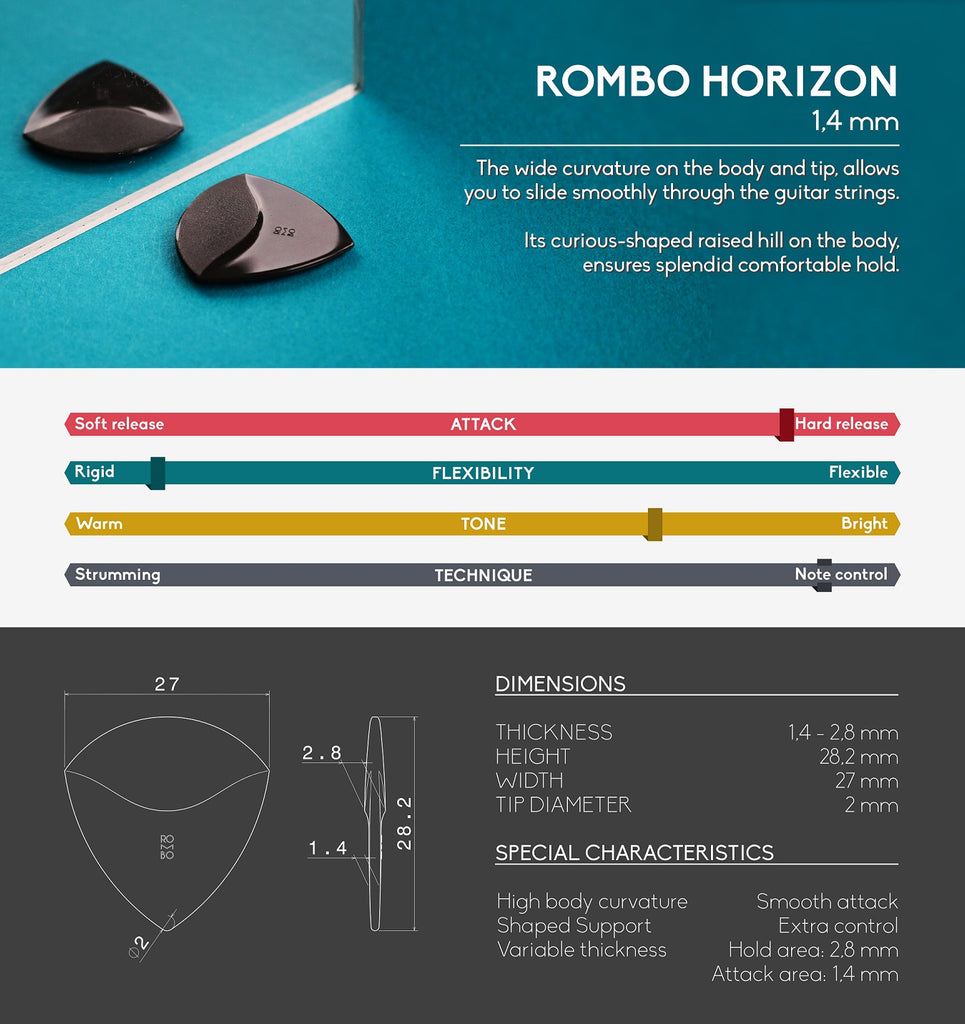
ROMBO PRISMA - 0,8 mm
A classic shape enhanced by modern surface technology. The geometry on the main body has different height levels for the most comfortable holding and grip.

ROMBO CRISP - 1 mm
Medium thickness combined with geometric concave design surfaces. The result? unexpected flexibility with great bass tones. Its medium-sharped tip provides extra warm tones.

ROMBO JADE - 2,3 mm
Maximum precision. Perfect for shredding guitar techniques. Its wide bevel edge, combined with a decent body thickness, provides a supreme attack, without compromising bass tones.


7 Wege, um Plektrumgeräusche zu vermeiden
Plektrumgeräusche lassen sich nicht ganz vermeiden. Insbesondere bei der Aufnahme von Akustikgitarren neigen Plektren dazu, viele Klick- und Klackgeräusche und Geräusche zu erzeugen, die dein Spielerlebnis sowie das deiner Zuhörer ruinieren kann.
Beim Gitarre lernen, wirst du einen Punkt erreichen, an dem du dich auf die Übertragung von Emotionen, das wirkungsvolle Spielen und eine bessere dynamische Kontrolle konzentrieren möchtest.
Um Gitarrentechniken zu meistern, musst du jeden Ton, der von der Gitarre erzeugt wird, vollständig kontrollieren: beabsichtigte und unbeabsichtigte.

Ich persönlich denke, dass Plektrumgeräusche ein Teil des Gitarrenspiels sind, und ich genieße sogar einige Vintage-Aufnahmen, bei denen das Plektrumgeräusch fast absichtlich vorhanden zu sein scheint. In den meisten Fällen möchtest du es jedoch beseitigen.
Wir haben alle Tipps und Tricks zusammengefasst, von denen wir glauben, dass sie dir helfen können, die Geräusche beim Spielen mit einem Plektrum zu reduzieren.
1- Halte das Plektrum mit weniger Spannung
Gitarrenpicks erzeugen beim Zupfen/Anschlagen der Saiten Geräusche. Wenn du dein Plektrum lockerer hältst, hilft das sehr, da deine Finger einen Teil der Energie absorbieren, wenn das Plektrum auf die Saiten trifft.
Wir haben einen Artikel mit dem Titel „Wie man ein Gitarrenplektrum hält“ veröffentlicht, der alles enthält, was du wissen musst, um diesen Trick zu meistern.

Beim Aufnehmen kann es hilfreich sein, dein Instrument im Verhältnis zu den anderen etwas lauter zu machen. Dies ist eine in Studios übliche Methode, die den Gitarristen hilft, sich zu entspannen.
Egal, ob du eine Studio-Session, einen Jam mit deinen Freunden oder einige Solo-Relax-Sessions zu Hause planen, ein bewusstes Aufwärmen vor dem Gitarre spielen ist Pflichtprogramm.

2- Probieren verschiedene Winkel beim Anschlagen aus
Der Winkel des Plektrums im Verhältnis zu den Saiten ist das am meisten diskutierte Element, wenn es um Plektrumgeräusche geht.
Grundsätzlich gilt: Je weniger Plektrum mit den Gitarrensaiten in Kontakt kommt, desto weniger Lärm erzeugt es. Deshalb winkle das Plektrum leicht zu den Saiten an.
Probiere verschiedene Winkel beim Anschlagen und Zupfen aus. Dies erfordert eine bewusste Anpassung deinerseits, aber sobald du es gemeistert hast, kannst du den Anschlag des Picks leichter variieren.
Abhängig vom verwendeten Plektrum, dem Musikstil und den Gitarrentechniken, die du verwendest, und deinem Können, benötigst du einen anderen Anschlagwinkel. Konzentriere dich also 30 Minuten darauf, den besten für dich zu finden, und gewöhne dich daran, diesen zu spielen.
3- Ist deine Schlagkraft passend?
Manchmal spielt man und der Flow setzt ein, man verlässt gedanklich den Raum und betritt „die Zone“, diesen schönen Ort, an dem man besser klingt als sonst.
Wir gehen so sehr in die Musik hinein, dass wir natürlich härter zuschlagen.

Übermäßige Anschlagkraft ist eine der häufigsten Ursachen für Plektrumgeräusche. Darüber hinaus kann es das Sustain abwürgen und dazu führen, dass die von dir gespielten Noten auf viel weniger natürliche Weise ausklingen.
4- Nylon-Gitarrenpicks sind weniger laut
Das Material der Gitarren-Plektren beeinflusst nicht nur den Ton, sondern auch das Geräusch, das das Plektrum erzeugt.
Nylon gilt als eine der am wenigsten lauten Formeln, wenn es um industrielle Materialien geht, die für Gitarrenpicks verwendet werden.
Dies liegt an der Zähigkeit dieser Mischung, die dank ihrer mechanischen Eigenschaften starke Stöße effizient absorbieren kann.

Bei Rombo verwenden wir eine modifizierte Version von Nylon, die für zusätzliche Haltbarkeit sorgt und die Lebensdauer der Plektren verlängert. Dies war notwendig, da Gitarrenpicks aus Nylon sehr schnell verschleißen. Hier erfährst du mehr über die Materialien.
Wenn du dir nicht sicher bist, ob du das richtige Plektrum verwenden, ist ein Variety-Paket eine gute Option, das Gitarrenpicks mit unterschiedlichen Attributen enthält. Dies ist eine gute Möglichkeit, mehrere Picks zu testen und deine Entwicklung zu verfolgen, während du beginnst, deine Fähigkeiten für jedes einzelne Plektrum zu verbessern.
5- Die richtige Dicke des Plektrums
Als Faustregel kann man sagen, dass schwerere Plektren weniger laut sind, was irgendwie widersprüchlich klingt. Aber warum ist das so?

Die Verwendung sehr dünner Plektren in Kombination mit schnellem Spiel, wie Strumming, führt dazu, dass sich die Plektren verbiegen, wenn sie die Gitarrensaiten verlassen, wodurch eine Art Klickgeräusch entsteht. Dies geschieht besonders beim Spielen von Akustikgitarren, da der Korpus der Gitarre als Verstärker für diesen Klang fungiert.
Schwerere Plektren lassen jede Saite ihren eigenen Ton ohne viele Begleitgeräusche erzeugen.

Die variable Dicke, die in allen unseren Gitarrenplektren enthalten ist, verbessert nicht nur die Kontrolle, sondern reduziert auch das Rauschen. Der Körper des Plektrums ist dicker und steifer, während die Spitze dünner und flexibler ist. Mit diesem Merkmal wird die Gesamtflexibilität der Spitze verringert, während ihre ursprüngliche Dicke und ihr ursprüngliches Material beibehalten werden. Das bedeutet mehr Kontrolle und weniger Lärm.
Dicke vs. dünne Plektren. In diesem Artikel besprechen wir alle Aspekte, die einen Unterschied machen.
6- Eine abgeschrägte Kante kann helfen, das Pickgeräusch zu reduzieren
Plektren mit einer abgeschrägten Kante gleiten besser und verursachen weniger Geräusche. In Kombination mit dem bereits erwähnten Anschlagwinkel können sie dir dabei helfen, das Plektrumgeräusch stark zu reduzieren.
Auch die Form und Größe des Plektrums sind wichtig, aber das ist eher eine Frage der Präferenz.

7- Reduziere Plektrumgeräusche mit einem Plektrum mit polierter Spitze
Wir haben häufig darüber gesprochen, welchen Einfluss eine polierte Spitze auf den Ton und die Haltbarkeit eines Gitarrenpickels hat.
Eine polierte Spitze gleitet auch ganz leicht über den Rand der Gitarrensaite. Auf der anderen Seite erzeugen Gitarrenplektren mit einer raueren Textur an der Spitze eine stärkere Höhenwiedergabe, selbst wenn sie am Rand gespielt werden. Dies passiert auch, wenn die Picks beginnen, sich abzunutzen.

Einige puristische Gitarristen bevorzugen jedoch, wie am Anfang des Artikels erwähnt, das Plektrum sogar, um Geräusche zu erzeugen, und haben es extra in ihre Aufnahmen eingebaut.
Bonus: Nimm dich sich selbst auf
Sehr erfahrene Live-Spieler, die nicht viel Studioerfahrung haben, reflektieren manchmal nicht genug über all die kleinen Nuancen ihres Spiels.

Eine gute Übung, um dies zu vermeiden, ist sich selbst aufzunehmen. Es ist erstaunlich, wie viel wir verpassen, wenn wir in die Zone kommen. Du wirst beim Anhören deiner Tracks Plektrengeräusche bemerken und es ist viel einfacher, kritische Bereiche zu identifizieren, als während des Spielens.
Wenn du Akustikgitarre spielst, versuche, das/die Mikrofon(e) an verschiedenen Orten zu platzieren, du wirst feststellen, wie viel Unterschied es in Bezug auf das Plektrumgeräusch machen kann.
Abschluss
Wir können Plektrengeräusche nicht vollständig eliminieren, aber es gibt genug zu tun, um unser Spiel zu verbessern und es erheblich zu reduzieren.
Der beste Weg, Plektrumgeräusche zu reduzieren, besteht darin, sich dessen bewusst zu sein und über dein Spiel nachzudenken, um deine Fähigkeiten zu verbessern und verschiedene Plektren für verschiedene Stile und Gitarrentypen auszuprobieren.
Wenn du eine neue Möglichkeit entdeckst, den Plektrum-Lärm zu reduzieren, lass es uns bitte wissen, damit wir es in den Artikel aufnehmen können!

New guitar picks for 2021 - How over 1500 guitar players helped us co-design our guitar picks:
In May 2020, Judith and I had finished the first 3D sketches of our four new guitar pick models. However, the picks weren’t 100% ready.
The thickness, the size, and even the names of the picks were still undefined.

We decided to take a new approach and involve as many guitarists as possible to help us co-create our new guitar picks.

What is a signature guitar pick:
Signature guitar picks are common in the guitar pick world.
These picks were developed with the help of some expert and famous guitarists from a specific music field.
From our point of view, this is a very narrow design path that only considers the opinion and guitar playing style of one person.
Our approach: The opposite of a signature pick:
The guitar community has strongly supported Rombopicks since its beginning in 2019.
We did not want to create new guitar picks without asking the people who have been with us since the beginning. You guys and girls are the core of Rombo, and you should decide which products we develop.
The most logical step was to create a big survey to allow users to tell us how they prefer their guitar picks.
We think this is the only way to develop our guitar picks, based on the wants of our users, allowing us to make essential decisions about our company's direction.

This is only possible by listening to the thoughts of every guitar player.
In addition, by asking precise questions about guitar picks, we are able to create more awareness of complex issues, like: Why are guitar picks thick or thin? How they behave when the size changes? Does the flexibility of a guitar pick affect the tone? What about the material?
When the user is aware of the product features, he/she can deliver a useful vote.
Since the beginning, we have been researching all these areas and are sharing them with you. With every article about plectrums we have written, we have contributed to the knowledge you have about your gear so you will be able to decide which gear is the best for you and understand why.
The results of the survey:
Participants:
1.552 guitar players (including us) have participated in the survey and therefore have took part in the design process of these new guitar picks for 2021.
336 of them left a private message with detailed information.

What is your favorite guitar pick design?

Pick number1: 18,8%
Pick number 2: 14,8%
Pick number 3: 27,8%
Pick number 4: 38,7%

Guitar Pick Number 1:

Name:
Rombo Horizon: 34,5%
Rombo Sense. 33,9%
Rombo Summit: 14,1%
Rombo Mood: 7%
Other names: 10,5%
Average Thickness: 1,378 mm
Average Size: Medium Size with 71% of the votes
Guitar Pick Number 2:

Name:
Rombo Prisma: 76%
Rombo Spin: 7,7%
Rombo Treble: 8,4%
Other names: 7,9%
Average Thickness: 0,831 mm
Average Size: Large Size with 73,5% of the votes
Guitar Pick Number 3:

Name:
Rombo Crisp: 47%
Rombo Split: 22,1%
Rombo Prisma: 16,4%
Other names: 14,5%
Average Thickness: 1,028 mm
Average Size: Medium Size with 59,7% of the votes
Guitar Pick Number 4:

Name:
Rombo Jade: 33%
Rombo Shift: 17,6%
Rombo Slope: 12%
Rombo Summit: 10%
Rombo Dune: 7%
Rombo Cascade: 7%
Rombo Wizzard: 4,9%
Other names: 8,5%
Average Thickness: 2,37 mm
Average Size: Small Size with 56,6% of the votes
Guitar picks: Personal thoughts of 336 guitar players
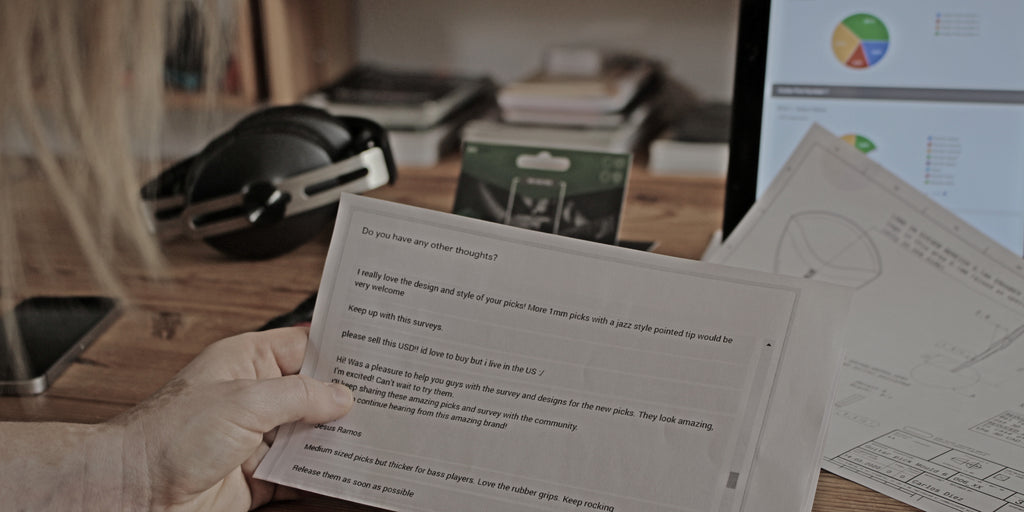
A total of 336 people left us a private message regarding guitar picks.
We have read all of them carefully and we will use all this information during the development.
Here are the important questions we have received and our comments to them:
-
Will the guitar picks be available in new colors?
Not at the moment. However, we are thinking about creating some additional colors for special editions in the future.
-
Will they have the same grip structure?
Yes! Definitely. Lots of people have sent us e-mails and letters regarding the grip structure. With the micro-nodules, we have the advantage of medium-grip surfaces which add lots of control.
However, a very small number of people want the picks to have more grip. We had to make a decision here, and it was hard.
We won’t forget this topic: In the future, we want to develop a texture with more grip for these players.
-
Why don’t you create different guitar pick thicknesses for each one of the models?
We want every guitar pick to be unique. As every person has unique preferences, we believe every guitar pick should have its own design.
In the future, we hope to be able to create a bigger quantity of different plectrum designs to cover each possible necessity.
-
What about picks for bass players?
Most our picks are compatible with bass, as we have confirmed this with some bassists that are using them regularly, especially Rombo Diamond ad Rombo Origami. We explained this HERE.
-
You should create some merch, T-Shirts and other stuff:
Maybe in the future. Now, we want to focus 100% on the development of the guitar picks. Every minute we spend on the design of a T-Shirt will be taken away from the quality of the picks! ;)
-
Will you offer the EcoBlack range in other colors?
The EcoBlack material can only be produced in one color at the moment. The recycling process creates a very dark pigmentation. The industry is working hard to find a way to create new recycling processes. We hope we will manufacture all of our picks out of recycled material in the future.
When will be the new picks available?

The new guitar picks will be available in early 2021.
If you want to receive an E-Mail as soon as the picks are availabe, join our mailing list below on the footer.
This is the timeline we created for this project:
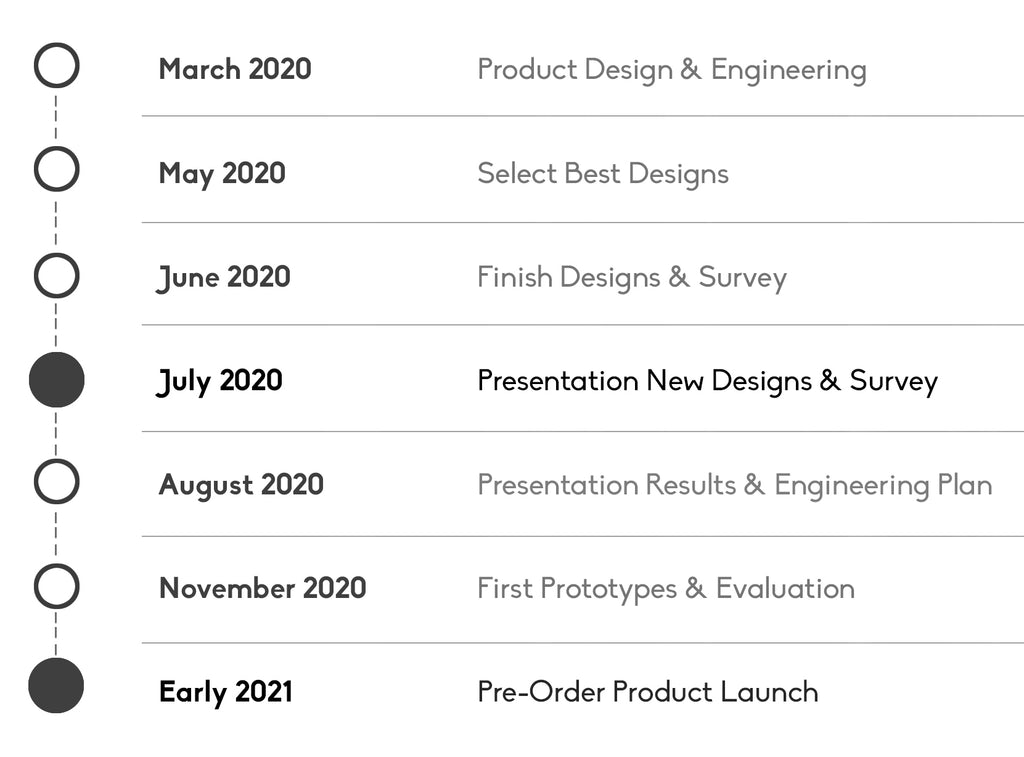
The pre-order product launch will be on the platform Kickstarter (like the first generation of Rombo guitar picks we launched in January 2019).
However, the current development of the Covid-19 could postpone the project a couple of months. We want to launch the product when we are able to deliver worldwide.
Why Kickstarter?
Kickstarter campaigns turn dreams and ideas into reality. Rombo is still a small start-up run by two people, and with limited access to resources. Through Kickstarter, we involve the community of guitar players, showing our guitar picks before launching.
This process brings us in contact with the real guitar players and their necessities. It forces us to remain flexible, accept changes, and challenges us to create new designs to fulfill the expectations of our audience.
We love open and critical criticism, and this is the best place to get it, where all comments and thoughts are visible. By sharing your experiences, we can listen to your needs and wishes, and create guitar picks that make a difference.

How To Hold A Guitar Pick
In case you are trying to learn the guitar, the first thing you need to know is how to hold a guitar pick the right way.
Guitar pick or plectrum is a small object that you hold in your hands and play the guitar strings. The quality of guitar you are playing depends mainly on the way you are holding its pick.
So, before you officially start learning guitar, you should learn to hold the plectrum in the right manner.
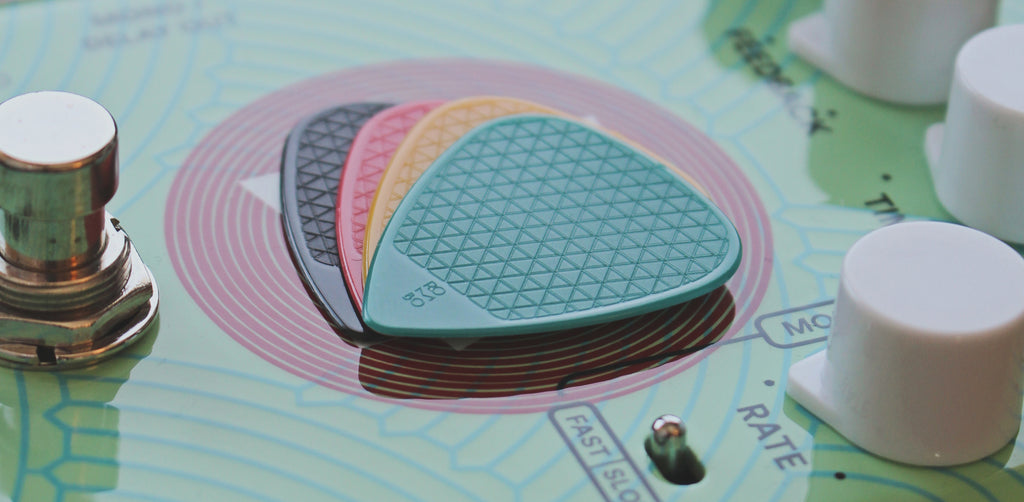
Mentioned below in this article are some of the tips and tricks which you can use for holding the guitar pick in your hand so that it doesn’t feel awkward and helps you in playing the guitar in the most suitable way.
Holding A Guitar Pick
The first and the easiest manner of holding a guitar plectrum is that you keep it in between your index finger and your thumb. Hold it in a way that it fits tightly in between your fingers. Now keep the position of your in such a manner that it can easily brush all the strings of your guitar.

As while playing, you will have to move the plectrum all over the strings and in order to be able to play guitar perfectly, the plectrum needs to touch all of the strings easily.
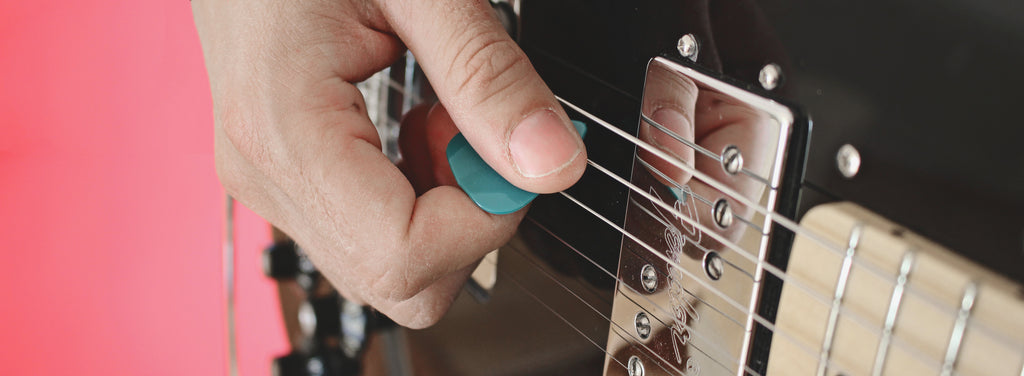
One thing that you need to keep in mind is that there are a lot of different types of plectrums available in the market and you should choose the one that works best for you. Once you have chosen the perfect pick, try to practice with it as much as possible.
We created a four-step guide to choosing your guitar pick, which you can find here:
https://rombopicks.com/blogs/insight-rombo/how-to-choose-the-right-guitar-pick
Brush it against the strings of your guitar so that your hands move easily and it produces a sound.
More Methods For Holding A Plectrum
Another technique that you can use to hold a guitar pick in your hand is that you keep it in your dominant hand. This is the hand that you use the most, so it will be easier for you to keep the plectrum in it and play the guitar.
Some people prefer to play the guitar chords with the hand that they don’t use more often i.e non-dominant. So by holding the plectrum in your dominant hand and controlling the chords with no dominant one, you can easily brush the guitar strings and produce music.

Now place your one hand on the neck of the guitar and hold the plectrum between your index finger and thumb of the dominant hand. Keep in mind that the strings of your guitar are facing away from you. Keep the guitar on your knees, as for a beginner, it is easier to play the guitar while sitting. But in case you want to play standing up, you can use a shoulder strap so that it is easier for you to control.
Keep your hand steady but flexible. Steady because you need to hold the guitar plectrum and flexible because you need to keep brushing it over all of the strings.

A good sound will only be produced if you are moving your hands the right way. Keeping them too rigid will result in an unpleasant sound which no one likes to listen to. But once again, keep in mind that a good sound can only be produced after practice.

During the initial times, you only need to focus on getting your hands used to the guitar. So that it knows where the strings are, which chords to play and where to keep the plectrums. These are the basic skills that everyone needs to learn before officially starting out various tunes on the guitar.
For those more advanced guitarists looking to improve their guitar playing speed, click HERE.
Things To Keep In Mind
Once you are in your comfortable position, rest your hand holding the plectrum on the strings of the guitar. Keep in mind that your hand should cover at least half of the plectrum. Some of the picks are made in a way that they are folded from one side to easily fit your index finger and your thumb on it.

Here you can find an example: Rombo Origami
Keep the grip of your hand as firm as possible but make sure it is easily movable so that once you start playing, you can brush the strings without making any extra effort. Never loosen your grip on the plectrum because it might fall off your hand while playing.
More Things To Focus
Now if you are a beginner, it is good that you are trying to get as much help as possible because this will help you in becoming a good guitarist within a minimum amount of time. By now, you do know how to carefully hold a plectrum (i.e between your index finger and thumb) now rest it over the strings.
Keep in mind that it should just lightly brush them so that only placing it there doesn’t produce any sound. The sound of your guitar must only be produced once you are moving the plectrum all over the strings.

One side of the strings is thin while the other one is thicker, practice on your guitar by gently moving your hand from the thicker side of the string to the thinner one. Although during the initial stages, rhythms produced would be rough but don’t worry about it. As you are only learning to hold the plectrum in the right way. There is a lot of time for learning guitar but prior to that, practicing is the most important thing that you need to do.
As this is the starting phase, try to practice as much as possible. As practicing will not only make your hand steady but it will also help you in maintaining your physical strength. The more your practice, the better you will be at playing guitar.
All successful guitarists need to play for hours in front of their audience and a person is only able to do that if he has done enough practicing.

So, in case you are taking more time trying to hold the guitar plectrum in the right way, tune the string or adjust the strap, don't worry about it. As all the great guitar players have started from this exact step so just polish your skills and you too will be an amazing guitarist really soon.
Note: There are many annoying things in life, but there’s nothing more annoying than losing a guitar pick you just had in your hand, and then realize that it has disappeared forever! - 4 Tips To Not Lose Your Guitar Picks
The Guitar Picks We Use Impact How We Play
If your hands do an arduous job, then you must give them the right tools, right?
The material with which it is made can influence the definition of tone, attack, and flexibility. Therefore, without paying attention to it, you could hardly find your personal sound.
Are you curious about the materials used for the Rombo guitar picks?
Read a full article about it here:
https://rombopicks.com/blogs/insight-rombo/guitar-pick-materials-at-rombo

Play Guitar Faster - Guitar Methods For Speed Playing
As a guitarist, you experience a very steep learning curve during the first months and years of your journey. All you need are an instrument, a guitar pick and a few songs to learn. Happy days.
Then you hit a wall that slows down the learning process.
You want to sound like those guitar idols of yours who inspired you to buy your first guitar. Further still, you want to create your own sound.
But how to take things to the next level?

Increasing your picking speed is a long journey full of ups and downs, obstacles and victories, and moments of personal fulfillment. Speed at guitar is a skill that requires patience and plenty of hard work.
The number of hours of practice is important. However, understanding the “right” way of practicing is the key to upgrading your skills.
If you are struggling to play something at the desired speed, it only means you have not defined a sufficiently effective practice routine.
For those looking to improve their guitar playing speed, the following insights will help get you where you want to be:
1. Use alternate picking and guitar pick rotation
Alternate picking is the most common guitar pick technique.
With the pick between your thumb and index finger and pointed toward the strings, you use strictly alternating down and up strokes.
Use the 45-degree rule from the picture. Simultaneously, rotate your thumb 45 degrees downwards. The guitar pick will glide very well and won't get stuck.

2. Loosen up your whole upper body
Every muscle is connected. Your hands, wrists, forearms, shoulders and back should all be performing their best during your practice.
Playing guitar can cause fatigue to these areas, and stretching helps to keep muscles loose and limber. It increases flexibility and your range of motion. Stretching before playing guitar will warm up muscle tissues and joints.
Playing faster will cause some areas to tense up. Try to be aware of all these areas and recognize where you should stay relaxed.
Finding the right balance between tension and relaxation will help you achieve greater accuracy and speed. It will also improve the way you hold your guitar pick.
Personally, I like to do some exercises with a ball before playing:
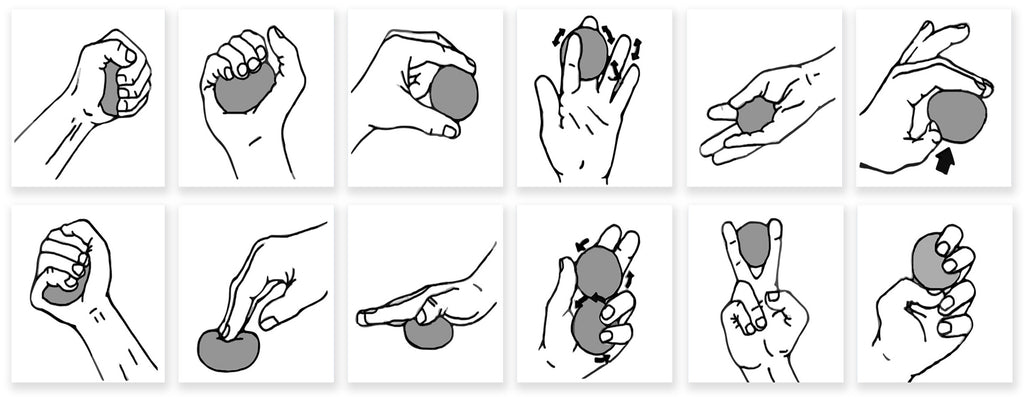
I also have some warm-up guitar scales and arpeggios, which I play every day for the first 5–10 minutes, and which include a variety of guitar techniques.
3. Use the wrist’s innate wave motion.
It is not only the motion of the thumb and index finger that will affect the way you play guitar. The muscles around your wrist are structured in a way to naturally promote back-and-forth movements.
Use them to play more efficiently, and to dissipate the fatigue in your fingers. This technique, combined with the 45-degree guitar pick rule, will achieve the fastest results at the beginning.
4 - Synchronize Your Fretting Hand and Picking Motion
Many players focus too much attention on their fretting hand. In order to play at higher speeds, it is essential to make both your hands work with equal efficiency and strength.
To establish the skill level of each hand, play through a passage with the picking hand only, then play the same notes with the fretting hand only. You will probably find that one hand is at least 20% faster than the other.
Now you know which hand is not working efficiently enough. Your goal is to get a deviation of less than 3% between both hands.
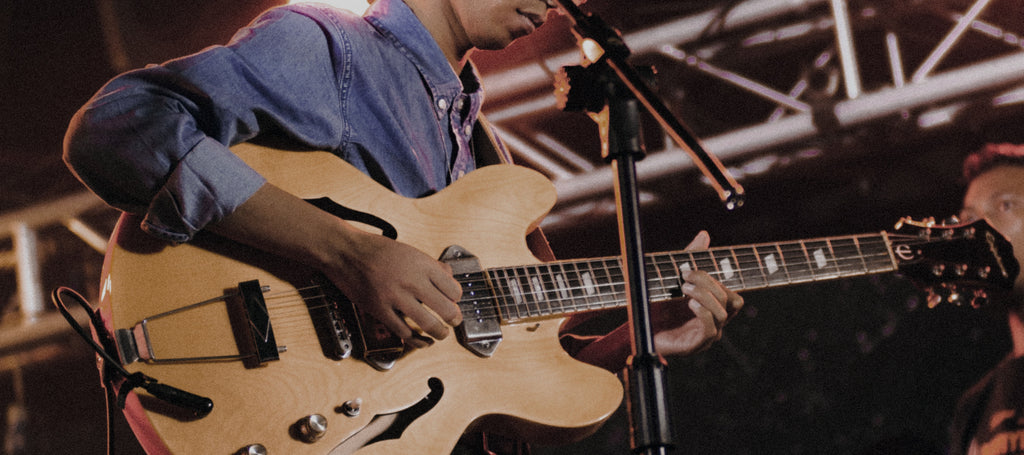
5. The right guitar pick:
Here are some reasons for there being such a huge variety of guitar picks available on the market:
- Each pick is designed to work to the optimum for different types of playing
- Each person (and guitar) has different anatomic nuances that will create a preference for certain shapes and materials.
- Certain guitar positions will influence the holding of the pick or the body tension.
Don’t overlook these factors, and don’t be afraid to try a large variety of guitar picks until you have found the right one for every style you play.
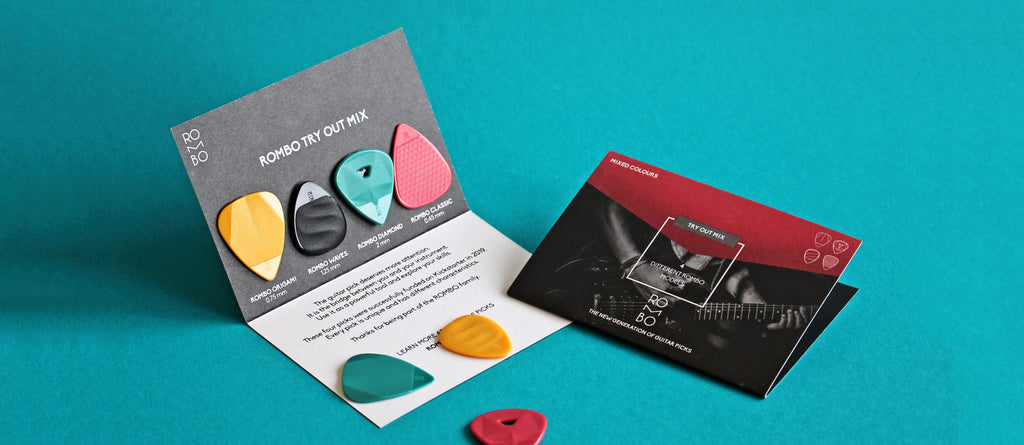
For guitar speed exercises, you should start with 1mm as a reference and then decide if this guitar pick thickness is enough. Thin, flexible picks take too much time to relax after hitting a note.
We created a four-step guide to choosing your guitar pick, which you can find here:
https://rombopicks.com/blogs/insight-rombo/how-to-choose-the-right-guitar-pick
6 - Use a metronome to play guitar
Speed is futile when you are playing without accuracy. The ability to play guitar in time at high speed is one of the most difficult skills to achieve.
Try to use a metronome and play fast, but also use slow tempos and increase your accuracy for different guitar techniques.
Using a metronome is one of the best ways to track your improvements and see your learning progression over time. It will also help you understand which techniques achieve results fastest, and where you should focus most.
After a while, you will learn to play in time without using a metronome because you will assimilate the feeling of playing in time naturally.
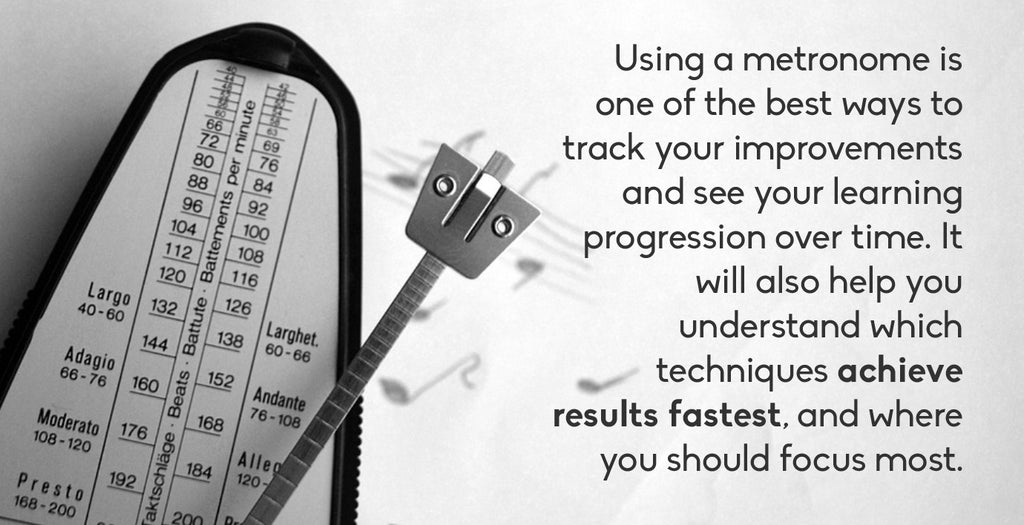
7- Always analyze your playing
Study both hands, analyze your position, reflect after each session and find your weaknesses. What doesn’t it work the way it should? Do you know why?
Ask yourself many questions and be critical of yourself. Create a scale and analyze every guitar technique to know where you stand on any particular exercise, and track your progress:
Create a guitar diary with notes and observations. If some techniques, songs or even specific fingers are too weak to speed up, be creative and create an exercise to encourage improvement in these areas.
Use technology to track your guitar learning progress. Record yourself while playing guitar, observe your posture and try to identify areas with too much tension. You can compare these with videos of professional players and find out which areas you should work on. Then, take corrective action if needed.

8- Integrate different guitar techniques
Don’t focus on just one technique at once. This approach will help you to improve isolated techniques, but most songs and solos combine different techniques that work fluently together in a song.
Focusing on only one technique might cause your guitar to sound unnatural and choppy.

Try to combine different techniques in 20-minute intervals. You also need to specifically practice different techniques together in the same way you will use them in real songs.
The extra advantage of this is that it will also help you produce richer compositions when you reach the point of creating your own songs.
Conclusion:
There is much you can do to speed up your skills on the guitar. Nevertheless, you must remember to be patient and accept that some processes reach a limit and cannot be rushed.
Developing patience is the most important skill for avoiding frustration at guitar. Remember that being a guitarist is a never-ending process. You will always struggle with new techniques and have ups and downs.
Question everything to find new paths and become a very expressive musician.
For example: are you using the right material for your guitar pick?
Find out here:
https://rombopicks.com/blogs/insight-rombo/guitar-pick-materials-at-rombo
Folge uns
Judith Heindorf & Carlos Diez Macia GbR
Auf der Steige 29
71686 Remseck am Neckar
DEUTSCHLAND
- Shop
- Händler
- Impressum
- AGB
- Widerrufsrecht
- Versandbedingungen
- Datenschutzerklärung
- Kontakt
- Presse
- Fragen & Antworten
Melde dich zu unserem Newsletter an und erhalte alle Neuigkeiten zu Sales, Neuerscheinungen und vielem mehr…
Mit der Anmeldung stimmst du unseren Datenschutzbedingungen zu.
© 2024 ROMBO.
ist eine registrierte EU-Marke.
Wir nutzen Shopify.




